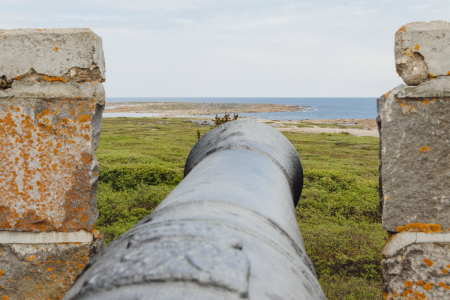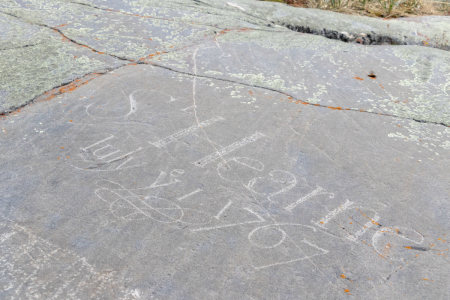The fort and forgotten American Revolution ‘battle’ at Hudson Bay in Canada’s far north

PRINCE OF WALES FORT, Hudson Bay — This stone fortress in the middle of nowhere was surrendered without the firing of a single shot during one of the final engagements of the American Revolution.
The battle that wasn’t really a battle at Prince of Wales Fort in Churchill, today a small town on Hudson Bay in the Canadian province of Manitoba, may be entirely forgotten, but was noteworthy because the combatants were neither the British Army nor the Continental Army under the command of George Washington. Rather, France, allied with the American cause since 1778, captured the valuable post belonging to the Hudson’s Bay Company.
HBC, a British commercial enterprise founded around the fur trade with a royal charter from Charles II in 1670, built the fort between 1731 and 1771 to replace an earlier wooden fort by the same name as part of its vast network of trading posts in present-day Canada. However, unlike the East India Company, its colonial-era counterpart on the Indian subcontinent, the company never had an army. Quite surprisingly, no regulars were ever sent to Churchill, though at least one Royal Navy ship with a compliment of sailors and marines wintered at the fort a few years after construction started.
The day was August 8, 1782, nearly a year after Washington’s victory in Yorktown had effectively won American independence and only weeks before John Adams, John Jay and Benjamin Franklin started negotiating a cessation of hostilities in Paris.
It is unclear what the fort’s governor, Samuel Hearne, a 37-year-old Englishman who been in the service of HBC since 1766, knew about the war. Surely, he was aware that British regulars had been sent as far north as the rival fur trading post at Grand Portage on Lake Superior in what is now Minnesota, nearly 800 miles away as the bird flies.

At some point someone — presumably a company trapper or trader doing guard duty — saw the sails of three ships from the north wall that looks out toward Eskimo Point and Hudson Bay. It was first thought these were British supply vessels, my Parks Canada guide told me. As the story went, it was Hearne who determined these were enemy vessels.
The French ships were under the command of 40-year-old Captain Jean-Francois de Galaup, better known as the count of La Perouse, and had sailed from Haiti with nearly 300 soldiers on orders to sack their ancient enemy’s commercial enterprises in Hudson Bay.
There had been conflict on these waters during wars between the European powers earlier in the 18th century, which makes the absence of British regulars or even a properly trained militia seem unthinkable in hindsight. After all, the British and French had coveted Hudson Bay and its vast drainage basin since the very founding of the Governor and Company of Adventurers of England trading into Hudson Bay, the official name given by Charles II’s charter to HBC.
Some company employees were certainly capable marksmen but few, if any, had the kind of military training needed to defend Prince of Wales Fort during a siege. Even if they had been trained there wasn’t enough of them to man the 40 cannons mounted at the parapets of the locally quarried limestone walls. Only Hearne had any real military experience, having served in the Royal Navy during the Seven Years’ War. This experience was enough for Hearne, arguably Britain’s most important 18th century explorer of the Canadian far north, to know his 38 poorly trained men were no match against La Perouse’s much larger force.
After Hearne’s quick surrender the French confiscated furs and other HBC property as prizes of war, spiked artillery and burned the fort’s interior structures. La Perouse then sailed south to the even more prosperous trading post of York Factory, which was surrendered but with considerably more difficulty for the French.
La Perouse allowed Hearne and the other prisoners to return on their own to the British Isles, as he wanted to get out of Hudson Bay before the weather trapped him for the duration of the long winter. No attempt was made by the French to occupy any of the outposts. Instead, they left as quickly as they came.
While Hearne returned after the American Revolution the fort was never rebuilt. Instead, ruins were left as-is and a new outpost of Fort Churchill was built on site of the original wooden fort some five miles upstream. It would ebb and flow as the fur trade changed in the 1800s and moved further inland and toward the Pacific. Eventually, the town that had sprung up relocated to its present location on the east side of the Churchill River after the railroad arrived in 1929.
Why Prince of Wales Fort was ever built could be discussed at length in the proper context of 18th century geopolitics, but it sure seems to have been a massive folly.
The ruins you see today, which are entirely original and in remarkable condition with sensitive restoration work ongoing, have the appearance of an impenetrable fortress. Yet, the fort was doomed to fall in the event of an attack.
Not only did the lack of soldiers make it undefendable, but critically there was no internal well for fresh water — an epic design flaw. One thing is for certain: It must have been an imposing sight for the Indians who had never seen a stone edifice, let alone a fort.
If you go
To access the Prince of Wales Fort National Historic Site you need to go through Lazy Bear Expeditions or Sea North Tours since Parks Canada doesn’t operate its own ferry across the Churchill River. It does, however, have a small visitors center and gift shop in the historic train station with exhibits and artifacts on display.

Beyond the fort is Sloop Cove, which served as the harbor before water levels dropped. Here you see the names of Hearne and others neatly carved into the stone landscape left by glaciers. Across the river is Cape Merry and the remains of an artillery battery that was built at the same time as the fort. Be sure to also visit the Itsanitaq (Eskimo) Museum, next to the Roman Catholic cathedral. The museum has an impressive collection of Inuit art and historic artifacts as well as the town’s best gift shop.
Getting to Churchill, despite its remote location on the shores of Hudson Bay, is much easier than you might think. In fact, thousands of visitors make the trek every year to the Polar Bear Capital of the World, as Churchills calls itself, to see polar bears and beluga whales. The tourist season has even expanded into the winter with the northern lights or aurora borealis.
Calm Air through its partner First Air has daily flights to and from Winnipeg using a tried-and-true Boeing 737-400 aircraft. Airfares can be very expensive, but my 90-minute flight featured great service and included a meal and complimentary nonalcoholic drinks. The only downside was Calm Air’s lack of interline agreements with bigger airlines. This means you need to factor in the time it will take to manually transfer your baggage and go through check-in formalities.
The only alternative is taking Via Rail’s train service from Winnipeg, a journey of about two days each way. Train tickets are considerably cheaper than airfares. If I had to do it over again, I would have flown to Churchill but taken the train home. Paying the extra money for a private sleeper cabin is worth it.
I stayed at the aptly named Polar Inn, one of Churchill’s best with clean and comfortable rooms, wireless internet, satellite television, daily housekeeping and complimentary breakfast each morning. The family-owned hotel also operates Sea North Tours.
Churchill also has more restaurants than you might expect. The café at Lazy Bear Lodge had the best food but didn’t serve alcohol. Tundra Inn Dining Room & Pub is popular with locals and serves beer, wine and spirits. Regardless of where you eat, order a bison burger or the local fresh fish (arctic char).
Spires and Crosses, a weekly travel column exclusive to The Christian Post, covers old churches, history and heritage, architecture, culture and art. Follow @dennislennox on Twitterand Instagram.





















